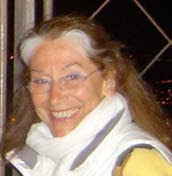 by Madeleine Kando
by Madeleine Kando
I am obsessed with the stars. Really obsessed. It’s not healthy. How can you love something that doesn’t love you back? Not just that, but stars don’t even know about my existence. It’s like being obsessed with the air, the ocean, the Siberian Tundra. That’s what we do, us humans: we become infatuated with things like that because it makes us feel more important than we are. If Jupiter and Mars are out there for us to see, doesn’t that mean that we somehow are part of it? Part of the vastness of space?
That obsession led to a conversation with my nine-year old grandson, Marshall. I told him that black holes sing. Not only do they sing, but they sing in B flat. It’s true. Go here, if you don’t believe me. Marshall and I had to first figure out what B flat sounded like. It sounds like this.
Black holes can generate enormous sound waves. They spew out vast amounts of material traveling at close to the speed of light. When that material slams into the hot gas that pervades the galaxy it is in, they beat a 'galactic drum'. The jet acts as the "stick," whereas the surface of the gas is the "drum”.
The problem is, that a black hole sings 52 octaves below middle C, or one million, billion times lower than the lowest sound audible to the human ear! But even if there were such a super-duper baritone-detecting creature, it would have to wait 10 million years between each sound wave (tone) to reach it. It would be a very slow symphony in B flat. (For a better explanation, see: Strange but True: Black Holes Sing).
We are so used to looking up at the night sky and marvel at the magic of it all. It is amazing how far our eyes can see. We see the moon at 239,000 miles. We have no trouble seeing the sun, at 93 million miles. Saturn, at 746 million miles, is visible in the night sky, and we can even see the entire Andromeda Galaxy, which is 2.5 million light-years away.
The Hubble Deep Field (HDF) image taken by the Hubble Telescope, shows galaxies so far away, that it allows us to travel back in time. It shows us the universe the way it was in the very beginning. Still, Hubble needs assistance to transpose those parts of the light spectrum that our naked eye can not detect, to give us a full picture of these stellar objects. Even the visual images we see, are always rendered in full color—converted from invisible X-rays or radio waves to visible light so we can see the universe in all its splendor. They might be a lot more boring if we limited ourselves to the visible range. Read more...








